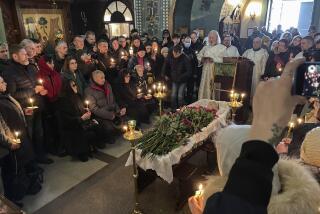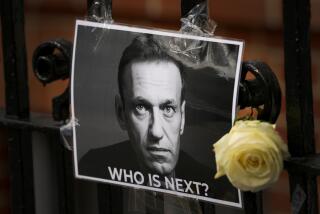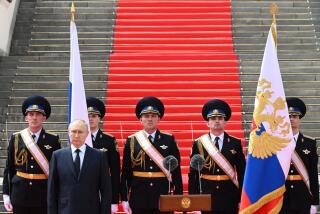Taboos on Dissent Lifted at Last, Soviet Citizens Wonder What to Do About Lenin : Reforms: Some call for an end to the âabsurd idolization.â Others rise in defense of the nationâs mostly unblemished hero.
MOSCOW â Yelena Yershovaâs glance shifted nervously from the 30 children in her charge to a steely-eyed policeman keeping watch over the silent procession to view V.I. Leninâs embalmed and enshrined body.
âThey should bury him,â the nurse from provincial Istra remarked in a whisper, shielding her young sanatorium patients from an opinion that her fellow pilgrims might consider sacrilege.
âHe was a normal man,â she said, reluctantly nudging along the ritual summer field trip. âAnd itâs abnormal to display a corpse for so many years.â
Such an assessment of the Soviet Unionâs founding father could have been condemned as an act of heresy only a year ago.
But as Soviet citizens struggle through an ideological identity crisis in a world that has all but abandoned communism, they have been forced for the first time since the 1917 Bolshevik Revolution to re-examine Leninâs theories, his role in history and even what to do with his deified remains.
For some Soviet citizens, the reassessment is a welcome outgrowth of the reforms that have broken longstanding taboos against honest reflection on how the nation founded by Lenin has evolved into a state in perpetual crisis.
But for the vast majority of Soviet people schooled to revere Lenin in the place of the god he disdained as the peopleâs opiate, Leninâs reduced standing in world esteem is the final indignity to be borne by a nation mired in a failing political experiment.
Bronze and marble images of the Soviet founding father have been firebombed in Poland, hanged in effigy in Romania, toppled in Hungary, defaced in East Germany and wrapped in a cocoon of anti-Communist slogans in Bulgaria.
In his native land, the ubiquitous Lenin statues have been clandestinely vandalized and his revolutionary philosophies publicly attacked. Even in the halls of the Moscow City Council, a giant bust of Lenin that has adorned political sessions for decades was turned to face the wall a few days ago.
Emotional assaults on his figurative presence in the newly democratized nations of Eastern Europe are understood by some Soviet people as the venting of pent-up rage by victims against a symbol of the system that repressed them.
But mounting calls from within the country to reassess Leninâs legacy have embedded doubts in the devoted masses who see the shift from official idolatry as a denigration of their last unblemished hero.
âMaybe he made mistakes, and some may have had serious consequences for us, and not all of his policies were appropriate even to the times,â historian Roy A. Medvedev observed in an interview on the eve of the 28th Communist Party Congress, at which the very future of Leninism will be determined. âBut no one can change the fact that he was the founder of the Soviet Union.â
While Lenin faces no serious challenge to his domestic standing, Medvedev argued, his tumble abroad was preordained because of the Soviet partyâs hand in imposing dictatorship in Leninâs name.
âFor the Soviet people, the attacks on Lenin in Eastern Europe have not had any tremendous effect. Soviet people are consumed with their own problems,â Medvedev said. âThese events might have upset the politicians and diplomats, but not the general population. If they are concerned about foreign public opinion, it is that of America, not Eastern Europe.â
No broad-scale trimming of Leninâs historical stature is needed, Medvedev said. But he applauded recent disclosures in Soviet periodicals of Leninâs political misjudgments, and even that he had a mistress, as a necessary humanizing of a figure too often placed above mortal weakness.
Until the past year, Leninâs image had been untouchable since his death in 1924.
Dictator Josef Stalin transformed him into a deity. Icon corners for worship in czarist schoolhouses were replaced with âLenin Cornersâ during Stalinâs 29-year rule. To this day, political altars and devotional testimonies surround the revolutionaryâs sage countenance in every classroom.
Hardly a city in the Soviet Union lacks a Lenin Square or a towering figure of the founder at its center. Countless towns, ships, oil fields and collective farms bear his name.
Leninâs fall from grace abroad was triggered by the spread of anti-Communist revolution that began peacefully in Poland last spring and swept through to Romania by the end of 1989.
His memory in the Soviet Union was seriously punctured last spring, with posthumous publication of Vassily Grossmanâs 1963 novel âEverything Flows,â tracing Stalinâs terror back to the foundation laid by Lenin.
âBolsheviks did not believe in the value of personal freedom, freedom of speech and press,â Grossman wrote. âThey, like Lenin himself, considered those freedoms . . . insignificant.â
In the months leading up to the crucial party congress, the search for socialismâs earliest errors has repeatedly cast aspersions on the teachings of Lenin. A book by a top playwright blames Lenin for the âcrime of the century,â the 1918 murder of ousted Czar Nicholas II and his family. Deputies to the Russian republicâs parliament have demanded investigation of the revolution led by Lenin.
The accusations prompted an outcry during April observances of the 120th anniversary of Leninâs birth, an occasion that drew words of caution even from President Mikhail S. Gorbachev.
âIt is high time we put an end to the absurd idolization of Lenin,â Gorbachev said. âNow we know the aim of this too well. But we condemn wholeheartedly the desecration of his memory, whatever form it takes in this country or abroad.â
Gorbachev alluded to the cunning of Stalin, who transformed the departed Lenin into a figure of worship to place party doctrine--and the dictatorâs actions--beyond reproach.
It was at Stalinâs insistence that Leninâs remains were embalmed and displayed for future generations, and Stalin was enshrined alongside Lenin in the red marble mausoleum for eight years after his death in 1953.
Much of the recent controversy over Leninâs place in history has been channeled into debate over whether to bury his remains and break with the 66-year tradition of preserving his image in the manner of an icon.
âNo matter how much we hate a person, no matter how much we love him, we donât have the right to deprive a person of burial,â theater director Mark Zakharov urged during a televised talk show last year.
Parliamentary Deputy Yuri Karyakin proposed a month later that authorities give serious consideration to interment.
The suggestion, which may resurface at the party congress that begins Monday, sparked an emotional public outcry.
âA man of Leninâs stature should be preserved by special means for all to see,â said Khuzhaboi Yusupov, a 31-year-old chemical worker from Uzbekistan who, as thousands do each weekday, stood for hours to be admitted to the mausoleum.
Preservation of the body, which some contend is a wax replica, is becoming an increasingly difficult task, requiring periodic closures for cosmetic adjustments.
âThe embalming of Lenin was not just Stalinâs wily action to make a place of worship for the party. It has become a cultural tradition and a symbol of an era, and that is something we have to respect,â said Ivan I. Antonovich, a prominent social scientist on the staff of the party Central Committee.
He said he personally advocates a closed tomb to âend the indignityâ of public display that Lenin has been exposed to. But Antonovich said the issue is beyond the partyâs resolution: âThe broad masses will never allow the reburial of Lenin.â
More to Read
Sign up for Essential California
The most important California stories and recommendations in your inbox every morning.
You may occasionally receive promotional content from the Los Angeles Times.











